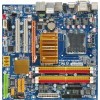- Qualcomm Launches Snapdragon 4 Gen 2 Mobile Platform
- AMD Launches Ryzen PRO 7000 Series Mobile & Desktop Platform
- Intel Launches Sleek Single-Slot Arc Pro A60 Workstation Graphics Card
- NVIDIA Announces Latest Ada Lovelace Additions: GeForce RTX 4060 Ti & RTX 4060
- Maxon Redshift With AMD Radeon GPU Rendering Support Now Available
Gigabyte EG45M-DS2H

On the test bench today, we have Gigabyte’s latest Micro ATX offering, the Intel G45-based EG45M-DS2H. This board carries the typical Gigabyte enthusiast charm, but also caters towards those looking to build a media center. But how does it stack up against the other Intel mATX boards we’ve tested recently?
Page 9 – Gaming: Call of Duty 4
Gaming usually isn’t the first thing on the minds of PC builders who use Micro ATX motherboards; typically, achieving a compact form factor or a low total price for a fully-functioning machine comes in higher on the list of priorities.
Gigabyte’s EG45M-DS2H is designed around this assumption, as I discussed several pages ago – instead of providing the typical direct 16-lane connection to the motherboard’s northbridge, they’ve chosen to use the 4-lane PCI Express controller in the ICH10R southbridge, favoring multi-monitor functionality over gaming performance.
We’re quite interested to see how this plays out in our game testing – does the ICH10R provide a modern discrete GPU with enough bandwidth to achieve acceptable performance in 3D gaming?
Call of Duty 4: Modern Warfare
Activision’s Call of Duty 4: Modern Warfare has been a mainstay of our graphics hardware test suite for quite some time, and its ability to scale well to lower-power GPUs made it a natural choice for our IGP motherboard testing. It’s multi-threaded, and its graphics engine is one of the most efficient in the business.
Our level of choice for graphics testing is “The Bog”, which is an extremely system-intensive level that features spectacular lighting, gunfire, and explosions, as well as fog and night-vision overlays. Our run consists of storming an apartment building and flushing the enemy out of their second-story hiding spot, and ends just as we’re leaving the building – on average, a four-minute scenario. Check out the Testing Methodology page of this article for more details on the settings used.

In a reversal of what we’ve been seeing so far in non-3D applications, the Gigabyte board pulls out a small victory over the only other G45-based motherboard we’ve tested so far, the Intel DG45ID. While none of the motherboards we compared managed playable frame rates, the gaming test gives us new insight into the board’s resource allocation strategy.
It’s likely that the reason for seeing worse performance in our memory bandwidth test was that more of the available memory controller bandwidth was being allotted to the onboard IGP, which makes the memory controller itself the bottleneck. Essentially, the CPU and IGP are ‘fighting’ each other for bandwidth, which makes the balance of bandwidth allocation to the CPU and the IGP extremely important.

As mentioned before, the Gigabyte EG45M-DS2H provides PCI Express bandwidth to its PCI Express x4 slot using the 4-lane controller in the ICH10R southbridge, instead of using the faster 16 lanes provided by the G45 GMCH northbridge as many other motherboards do. While this compromise is intended to allow the simultaneous use of both the onboard IGP and a discrete GPU to drive multiple monitors, as you can see, it has a significant effect on the motherboard’s ability to keep a modern midrange GPU like the NVIDIA GeForce 9600GT completely fed.
We ran the same level on both the Intel DG45ID board and the Gigabyte EG45M-DS2H, and the Gigabyte board turned in significantly lower performance numbers. Unfortunately, this means that the EG45M-DS2H is a poor candidate for a graphics ‘upgrade’ via the PCI Express x4 slot. If your plans included ditching the onboard graphics in favor of a discrete GPU, you’d probably do best to look somewhere else.

You’ll notice that our usual Half-Life 2: Episode Two test is absent from our benchmarking suite this round. Of the three motherboards being compared, only the G35-based ASUS board would actually allow the game to load – a known driver issue prevents Half-Life 2 from loading properly at a resolution of 1680×1050 or beyond.
It’s unfortunate that the same problems with immature drivers that we saw with the Intel DG45ID have carried over to the Gigabyte EG45M-DS2H, but we simply decided to forego the test until Intel can get their act together and actually correct this ludicrous driver problem. After all, the G35 worked perfectly at our desired resolution. Perhaps Intel should go back to their last-gen drawing board and figure out why the G35 has no problem with this four-year-old game, but the G45 does.
On the next page, we’ll wrap up with some final thoughts.
Support our efforts! With ad revenue at an all-time low for written websites, we're relying more than ever on reader support to help us continue putting so much effort into this type of content. You can support us by becoming a Patron, or by using our Amazon shopping affiliate links listed through our articles. Thanks for your support!





